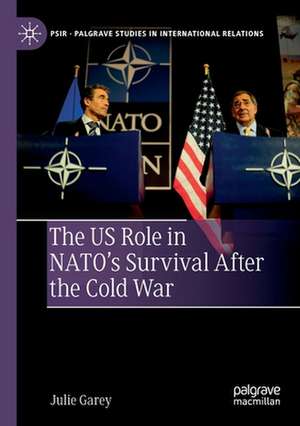The US Role in NATO’s Survival After the Cold War: Palgrave Studies in International Relations
Autor Julie Gareyen Limba Engleză Paperback – 14 aug 2020
| Toate formatele și edițiile | Preț | Express |
|---|---|---|
| Paperback (1) | 580.68 lei 6-8 săpt. | |
| Springer International Publishing – 14 aug 2020 | 580.68 lei 6-8 săpt. | |
| Hardback (1) | 586.05 lei 6-8 săpt. | |
| Springer International Publishing – 28 iun 2019 | 586.05 lei 6-8 săpt. |
Din seria Palgrave Studies in International Relations
- 8%
 Preț: 513.56 lei
Preț: 513.56 lei - 15%
 Preț: 654.77 lei
Preț: 654.77 lei - 17%
 Preț: 360.84 lei
Preț: 360.84 lei - 20%
 Preț: 692.07 lei
Preț: 692.07 lei - 20%
 Preț: 691.19 lei
Preț: 691.19 lei - 18%
 Preț: 625.59 lei
Preț: 625.59 lei -
 Preț: 388.72 lei
Preț: 388.72 lei - 15%
 Preț: 642.51 lei
Preț: 642.51 lei - 15%
 Preț: 583.28 lei
Preț: 583.28 lei - 18%
 Preț: 950.33 lei
Preț: 950.33 lei -
 Preț: 388.72 lei
Preț: 388.72 lei -
 Preț: 390.63 lei
Preț: 390.63 lei -
 Preț: 391.61 lei
Preț: 391.61 lei -
 Preț: 395.47 lei
Preț: 395.47 lei -
 Preț: 385.47 lei
Preț: 385.47 lei -
 Preț: 391.99 lei
Preț: 391.99 lei -
 Preț: 391.02 lei
Preț: 391.02 lei -
 Preț: 387.75 lei
Preț: 387.75 lei -
 Preț: 392.60 lei
Preț: 392.60 lei - 15%
 Preț: 637.75 lei
Preț: 637.75 lei -
 Preț: 387.96 lei
Preț: 387.96 lei -
 Preț: 390.63 lei
Preț: 390.63 lei -
 Preț: 388.13 lei
Preț: 388.13 lei -
 Preț: 391.61 lei
Preț: 391.61 lei -
 Preț: 383.93 lei
Preț: 383.93 lei -
 Preț: 381.00 lei
Preț: 381.00 lei -
 Preț: 391.61 lei
Preț: 391.61 lei -
 Preț: 392.60 lei
Preț: 392.60 lei -
 Preț: 386.81 lei
Preț: 386.81 lei -
 Preț: 389.70 lei
Preț: 389.70 lei -
 Preț: 392.60 lei
Preț: 392.60 lei -
 Preț: 391.61 lei
Preț: 391.61 lei -
 Preț: 388.72 lei
Preț: 388.72 lei - 15%
 Preț: 528.80 lei
Preț: 528.80 lei -
 Preț: 385.25 lei
Preț: 385.25 lei - 18%
 Preț: 781.94 lei
Preț: 781.94 lei -
 Preț: 382.36 lei
Preț: 382.36 lei -
 Preț: 383.71 lei
Preț: 383.71 lei -
 Preț: 384.86 lei
Preț: 384.86 lei -
 Preț: 390.63 lei
Preț: 390.63 lei - 15%
 Preț: 646.11 lei
Preț: 646.11 lei -
 Preț: 391.61 lei
Preț: 391.61 lei
Preț: 580.68 lei
Preț vechi: 683.15 lei
-15% Nou
Puncte Express: 871
Preț estimativ în valută:
111.13€ • 120.67$ • 93.35£
111.13€ • 120.67$ • 93.35£
Carte tipărită la comandă
Livrare economică 22 aprilie-06 mai
Preluare comenzi: 021 569.72.76
Specificații
ISBN-13: 9783030136772
ISBN-10: 3030136779
Pagini: 259
Ilustrații: XI, 259 p.
Dimensiuni: 148 x 210 mm
Greutate: 0.33 kg
Ediția:1st ed. 2020
Editura: Springer International Publishing
Colecția Palgrave Macmillan
Seria Palgrave Studies in International Relations
Locul publicării:Cham, Switzerland
ISBN-10: 3030136779
Pagini: 259
Ilustrații: XI, 259 p.
Dimensiuni: 148 x 210 mm
Greutate: 0.33 kg
Ediția:1st ed. 2020
Editura: Springer International Publishing
Colecția Palgrave Macmillan
Seria Palgrave Studies in International Relations
Locul publicării:Cham, Switzerland
Cuprins
1. Chapter 1: Introduction.- 2. Chapter 2: Alliances, NATO, and the Post-Cold War Era.- 3. Chapter 3: The 1999 Kosovo Intervention.- 4. Chapter 4: September 11, 2001 and the War in Afghanistan.- 5. Chapter 5: The 2003 Iraq War.- 6. Chapter 6: The 2011 Libyan Intervention.- 7. Chapter 7: The Evolution and Persistence of NATO.- 8. Chapter 8: The United States and Multilateralism.
Recenzii
“Julie Garey’s book arrives at an important time to reflect on post-Cold War and post-9/11 periods in the alliance, acknowledge the potential of both the United States and NATO, and draw les‐ sons for the future. Students and practitioners on both sides of the Atlantic would do well to read it.” (Seth A. Johnston, H-Net Reviews, h-net.org, October, 2021)
Notă biografică
Julie Garey is an Assistant Teaching Professor of political science at Northeastern University in Boston, Massachusetts, USA
Textul de pe ultima copertă
This book takes a new approach to answering the question of how NATO survived after the Cold War by examining its complex relationship with the United States. A closer look at major NATO engagements in the post-Cold War era, including in the Balkans, Afghanistan, Iraq, and Libya, reveals how the US helped comprehensively reshape the alliance. In every conflict, there was tension between the United States and its allies over mission leadership, political support, legal precedents, military capabilities, and financial contributions. The author explores why allied actions resulted in both praise and criticism of NATO’s contributions from American policymakers, and why despite all of this and the growing concern over the alliance’s perceived shortcomings the United States continued to support the alliance. In addition to demonstrating the American influence on the alliance, this works demonstrates why NATO’s survival is beneficial to US interests.
Julie Garey is an Assistant Teaching Professor of political science at Northeastern University in Boston, Massachusetts, USA
Julie Garey is an Assistant Teaching Professor of political science at Northeastern University in Boston, Massachusetts, USA
Caracteristici
Develops a more robust understanding of the US role in NATO Argues the causes of NATO’s persistence after the Cold War Provides deeper historical and political understandings of post-Cold War conflict engagements
